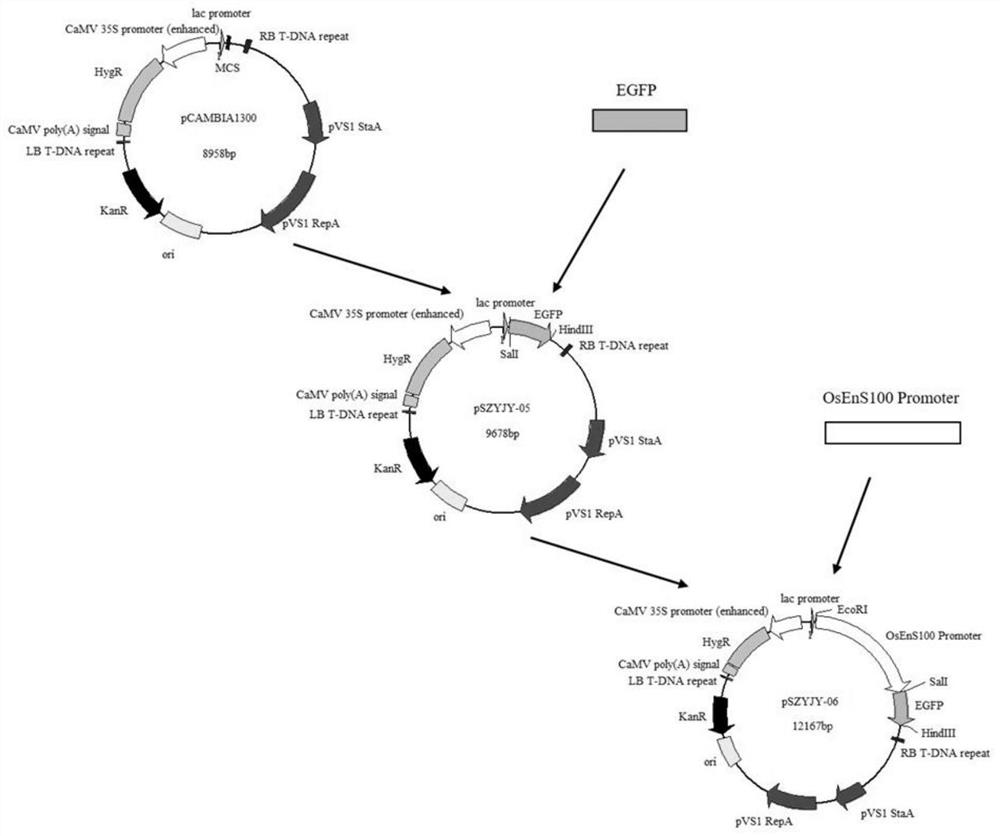Identification and application of a plant endosperm-specific expression promoter posens100
A promoter and endosperm technology, applied in the field of DNA application and isolated DNA, can solve the problems of waiting for a long time, high homology gene silencing, and the effect of improving the expression time and space of the target gene is not obvious. The effect of high expression
- Summary
- Abstract
- Description
- Claims
- Application Information
AI Technical Summary
Problems solved by technology
Method used
Image
Examples
Embodiment 1
[0042] Example 1, Tissue expression pattern analysis of OsEnS100 gene
[0043] In the research, the inventor accidentally found that the expression level of the rice OsEnS100 gene is significantly different in different tissues and organs. The roots, stems, leaves, palea, palea, pistil, anthers (Stage 6-12) and endosperm (DAP 7 and DAP25) of rice plants were taken respectively, RNA was extracted, reverse transcribed into cDNA as a template, and rice ACTIN gene As an internal reference, primers for OsEnS100 and ACTIN genes were designed respectively, and the expression of OsEnS100 gene in various tissues of rice was analyzed by Quantitative Real time-PCR (qRT-PCR) method.
[0044] The qRT-PCR primers for OsEnS100 gene are:
[0045] Primer 1: 5'-TGCGAGGCGATCAGCCACAT-3' (SEQ ID NO: 3);
[0046] Primer 2: 5'-GCCAGCCAGTAGCAGACACC-3' (SEQ ID NO: 4);
[0047] The qRT-PCR primers for the ACTIN gene are:
[0048] Primer 3: 5'-GCTATGTACGTCGCCATCCA-3' (SEQ ID NO: 5);
[0049] Primer 4...
Embodiment 2
[0055] Embodiment 2, the cloning of fluorescent reporter gene EGFP and promoter pOsEnS100
[0056] The primers required for cloning the fluorescent reporter gene EGFP are:
[0057] Primer 5: 5'-ATCCTCTAGAGTCGACATGGTGAGCAAGGGCGAGGAGCTGT-3' (SEQ ID NO: 7);
[0058] Primer 6: 5'-GGCCAGTGCCAAGCTTTTACTTGTACAGCTCGTCCATGCCG-3' (SEQ ID NO: 8);
[0059] The primers required for cloning the promoter pOsEnS100 are:
[0060] Primer 7: 5'-CCATGATTACGAATTCCGTGGCATGGTGCCCGGGGGTGGGG-3' (SEQ ID NO: 9);
[0061] Primer 8: 5'-TGCTCACCATGTCGACATTTTTGTTGCAGAAAATCTTAACT-3' (SEQ ID NO: 10);
[0062] Among them, the underlined sequence in primers 5 and 8 is the restriction site of SalI; the underlined sequence AAGCTT in primer 6 is the restriction site of HindIII; the underlined sequence in primer 7 is the restriction site of EcoRI. The 10 bases on the left side of the restriction sites of primers 5, 6, 7 and 8 are backbone vector recombination fragments, which are used for homologous recombinati...
Embodiment 3
[0065] Embodiment 3, the construction of expression vector pSZYJY-06
[0066] Such as figure 2 As shown, the reporter gene EGFP sequence recovered from the PCR gel in Example 2 was connected under the action of homologous recombinase In-fusion into the vector pCAMBIA1300 double-digested with SalI and HindIII, and the colonies were picked for PCR detection. The positive colonies were sequenced, and the sequence of the EGFP reporter gene was shown as SEQ ID NO: 2. After the sequence verification was correct, the corresponding positive clone plasmid was extracted and named pSZYJY-05.
[0067] Then, under the action of homologous recombinase In-fusion, the pOsEnS100 promoter sequence recovered from the gel in Example 2 was connected into the vector pSZYJY-05 which was double-digested with EcoRI and SalI again, and colonies were picked for PCR detection. Colonies with positive PCR results were sequenced. The sequence of the pOsEnS100 promoter was shown as SEQ ID NO: 1. After the ...
PUM
 Login to View More
Login to View More Abstract
Description
Claims
Application Information
 Login to View More
Login to View More - R&D
- Intellectual Property
- Life Sciences
- Materials
- Tech Scout
- Unparalleled Data Quality
- Higher Quality Content
- 60% Fewer Hallucinations
Browse by: Latest US Patents, China's latest patents, Technical Efficacy Thesaurus, Application Domain, Technology Topic, Popular Technical Reports.
© 2025 PatSnap. All rights reserved.Legal|Privacy policy|Modern Slavery Act Transparency Statement|Sitemap|About US| Contact US: help@patsnap.com



